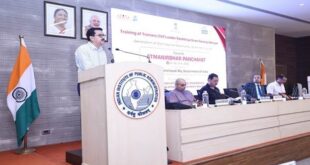- There was reduced noise pollution on the surface of earth during the Covid-19 pandemic owing to lockdowns and stop of economic activities (like international trade).
- In the underwater world, too, anthrophony (human-made sounds) reduced substantially for long months.
Important Points
The three broad components of oceanic acoustics are:
- Geophony: Sounds created by non-biological natural events like earthquakes, waves and bubbling.
- Sounds created by the ocean’s living creatures.
- Anthrophony: Sounds created by human beings (a large portion of which is shipping noise).
- According to ‘the Soundscape of the Anthropocene Ocean report’ published in Science Journal in 2021, geophony and biophony dominated the soundscape of oceans before the industrial era.
- However, now, anthrophony interferes with and alters these natural components.
- The oceans of the current geological era (Anthropocene era – when human-made disruptions largely influence the environment) are noisier than the pre-industrial times.
- During the first few days of the pandemic, ocean sound monitors at several places recorded a decibel (dB) drop.
- The hydrophones at the Endeavour node of Canada’s Neptune Ocean Observatory showed an average decrease of 1.5 dB in year-over-year mean weekly noise power spectral density at 100 hertz.
Impact of Anthrophony:
- In the short term anthrophony masks the auditory signal processing by marine animals, weakening their ability to forage for food, escape a predator or attract a mate.
- In the long run, it can thin out the population of some underwater species.
- It is an international scientific program to promote research, observations, and modelling to improve understanding of ocean soundscapes and effects of sound on marine organisms.
- It started in 2015 and will go on till the end of 2025. The IQOE team has gathered large quantities of data during the Covid-19 pandemic.
- IQOE is developing methods to make ocean acoustic data more comparable. These data will be compiled into a global dataset to establish trends in ocean sound and look for effects of the Covid-19 pandemic on ocean sound.
- The IQOE has identified a network of over 200 non-military hydrophones (underwater microphones) in oceans across the world.
- Most of the hydrophones in the network of this project are along the shores of the USA and Canada. Now the presence is increasing in several other parts of the world, especially Europe.
- These hydrophones (that pick up even faraway low-frequency signals) have recorded sounds from whales and other marine animals, as well as those emanated by human activities.
Hydrophone
- Just as a microphone collects sound in the air, a hydrophone detects acoustic signals under the water.
- Most hydrophones are based on a special property of certain ceramics that produces a small electrical current when subjected to changes in underwater pressure.
- When submerged in the ocean, a ceramic hydrophone produces small-voltage signals over a wide range of frequencies as it is exposed to underwater sounds emanating from any direction.
- By amplifying and recording these electrical signals, hydrophones measure ocean sounds with great precision.
SOURCE: THE HINDU,THE ECONOMIC TIMES,MINT
 Chinmaya IAS Academy – Current Affairs Chinmaya IAS Academy – Current Affairs
Chinmaya IAS Academy – Current Affairs Chinmaya IAS Academy – Current Affairs



